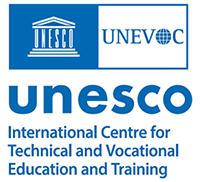
The UNESCO-UNEVOC International Centre: Who We Are | What We Do | Working With Us | Get in Touch
The UNEVOC Network: Learn About the Network | UNEVOC Network Directory
For Members: UNEVOC Centre Dashboard
Thematic Areas: Inclusion and Youth | Digital Transformation | Private Sector Engagement | SDGs and Greening TVET
Our Key Programmes & Projects: BILT: Bridging Innovation and Learning in TVET | Building TVET resilience | TVET Leadership Programme | WYSD: World Youth Skills Day
Past Activities: COVID-19 response | i-hubs project | TVET Global Forums | Virtual Conferences | YEM Knowledge Portal
Our Services & Resources: Publications | TVET Forum | TVET Country Profiles | TVETipedia Glossary | Innovative and Promising Practices | Toolkits for TVET Providers | Entrepreneurial Learning Guide
Events: Major TVET Events | UNEVOC Network News
Innovation is defined as a substantial change in the way TVET is practised in an institution, making it more relevant to the needs of the economy, society and environment. Innovation also encompasses non-R&D activities that are developed by TVET institutions from an existing stock of knowledge or knowledge external to the institution, not only through internal systematic R&D activities.
(see also UNEVOC innovation framework)
 Source:
Source: UNESCO-UNEVOC, Innovating technical and vocational education and training: A framework for institutions, 2020
UNESCO-UNEVOC, Innovating technical and vocational education and training: A framework for institutions, 2020
The term “innovation” can refer to the process of developing an innovation or an output, such as a specific type of innovation. To avoid confusion, this paper uses the term “innovation activities” to refer to innovation as a process, and the term “innovation” for outputs. The term “outcome” is used to refer to the effects of innovations on the innovating organisation itself (as with process innovations) or on the users of innovations (as with the users of educational services).
Innovation activities include all developmental, financial, and commercial activities undertaken by an organisation to create an innovation. The organisation of innovation activities can vary for each innovation and between institutions. An innovation can be developed through dedicated projects with an allotted budget, through ad-hoc “back of the desk” activities without a dedicated budget, or as part of regular operations to continuously improve processes or services.
 Source:
Source:Innovation is the spark of insight that leads a scientist or inventor to investigate an issue or phenomenon. That insight is usually shaped by an observation of what appears to be true or the creative jolt of a new idea. Innovation is driven by a commitment to excellence and continuous improvement. Innovation is based on curiosity, the willingness to take risks, and experimenting to test assumptions. Innovation is based on questioning and challenging the status quo. It is also based on recognizing opportunity and taking advantage of it.
In the world of education, innovation comes in many forms. There are innovations in the way education systems are organized and managed, exemplified by charter schools or school accountability systems. There are innovations in instructional techniques or delivery systems, such as the use of new technologies in the classroom. There are innovations in the way teachers are recruited, and prepared, and compensated. The list goes on and on.
Innovation is defined as “the process of making changes to something established by introducing something new.” It applies to “…radical or incremental changes to products, processes or services.” (wikipedia![]() ) Over the years there have been many changes in the way education is designed and delivered in parts of the world.
) Over the years there have been many changes in the way education is designed and delivered in parts of the world.
 Source:
Source:Implementation of a new or significantly improved product (good or service), or process, or a new marketing method, or a new organizational method. The minimum requirement for an innovation is that the product, process, marketing method or organizational method must be new (or significantly improved in the case of product or process) to the firm.
OECD and Eurostat (2005), Oslo Manual: Guidelines for Collecting and Interpreting Innovation Data![]() , §146, 148.
, §146, 148.